SIRT2 and Insulin Resistance: Lets Talk About Another Mouse Study
Today we are going to discuss an article published in the journal PLoS One Titled "SIRT2 knockout exacerbates insulin resistance in high fat-fed mice." As looking for relationships between enzyme functions and development of diabetes (insulin resistance) is a topic that interests me. I hope its one that you might want to learn about too.
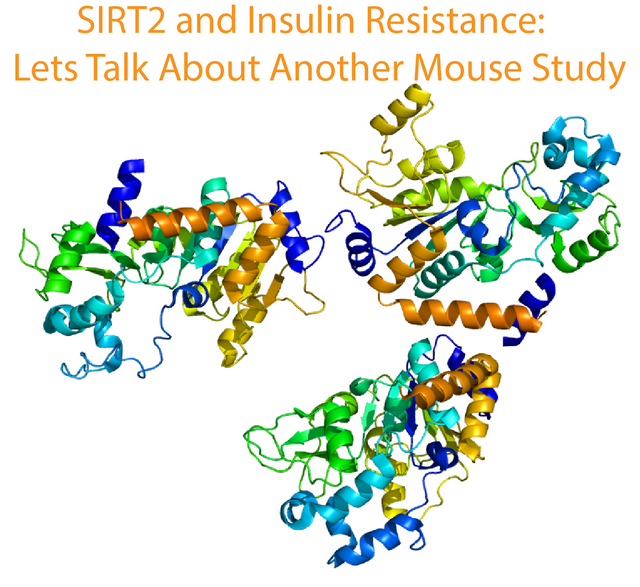
What Is SIRT2?
SIRT2 is a member of the enzyme class known as sirtuins. These enzymes are deacetylases, meaning they are responsible for removing acetyl groups from lysine residues of proteins. They do this through a reaction catalyzed by nicotinamide adenosine dinucleotide (NAD+), which serves as an electron acceptor, and is the recipient of the acetyl group removed from the protein that SIRT2 acts upon. Most sirtuins are found either in the cytosol of the cell or the mitochondria, however SIRT2 is unique and is found both. Thus it has potential to play a role in both metabolic and general cellular functions. (Note there are 3 other sirtuins which are only in the mitochondria SIRT3-SIRT5 [2]). Corroborating that idea is the fact that nutrition plays a role in mitochondrial protein acetylation levels [3]. Where increased energy intake results in higher levels of acetyl-CoA and as a result increased levels of protein acetylation. [4] As increased Acetyl-CoA concentration leads to increased activity of acetyltransferases.
Interestingly a link between mitochondrial acetylation and impairments to the metabolism of glucose have also been described. [5] Thus the authors of today's article hypothesized that knocking out SIRT2 (remember it is a deacetylase) should result in drastically increased protein acetylation levels (including in the mitochondria) leading to reduced sensitivity to insulin and the resultant poor glucose metabolism.
Data Time
The authors did just this, generating SIRT2 knock out mice [as described previously in [6]] and fed them one of two diets: one low in fat, fat constituting ~13% of total calories, and another high in fat, fat constituting 60% of total calories. They then monitored what effects the knockout had on the metabolism and phenotype of the mouse on the two diets.
Body Mass
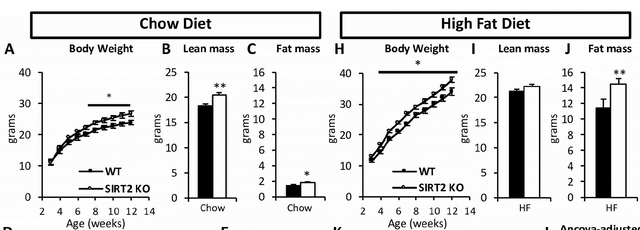
Looking at the weight gain of the mice over the course of 14 weeks we can see that the SIRT2 knockout mice on a normal diet had a slightly elevated body weight relative to the mice with SIRT2 still intact, and that this difference came in the form of an increased amount of lean muscle mass rather than fat mass. However the mice which were fed on the high fat diet we see that this has shifted, and the SIRT2 knock out mice have significantly greater fat mass than the mice with SIRT2. Interesting, and points to metabolic changes between the two mouse types. The authors discuss (for data see publication) that these mass changes did not come with a change in overall energy expenditure by the animals (the SIRT2 knock out mice were just as active as the wild type mice). So why did the knock out mice gain more weight? Well they did so because they were actually eating more food than their wild type counterparts.
Epic Meal Time
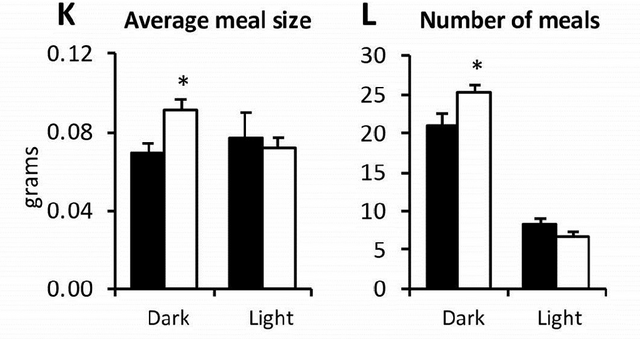 Reproduced from [1] Figure 3
Reproduced from [1] Figure 3In the image to the left we can see that the knockout mice (white) ate more meals, and each meal was bigger than the wild type mice (black). The feeding is also divided up between light and dark cycles, mice are nocturnal and as such do most of their eating at night (dark cycle).
Tangential Blabbing (Ye who enter here may leave with less brain cells):
The authors included some supplemental data looking at acetylation levels of brain protein extracts from the mice. The data seems to indicate that there is an increase in acetylation in the SIRT2 knockout mice, however I don't care for the figure (it was in the supplemental, and I can see why it didn't make it into the main text). Potentially interesting, but nothing to write home about. TL;DR knocking out a deacetylase resulted in increased acetylation of a brain protein of 42 kilodaltons in size. Not much more info than that.
The Phosphorylation of Swole
The authors probed a variety of insulin related responses in muscle and came up relatively empty handed relative to changes. There were some changes in insulin controlled phosphorylation of the muscle protein AKT which is a kinase which is activated by phosphorylation, and then goes on to phosphorylate a variety of other protein targets. It plays a role in muscle hypertrophy and atrophy. An interesting result, and leaves room for further study but does not address the initial hypothesis.
Liver Insulin City
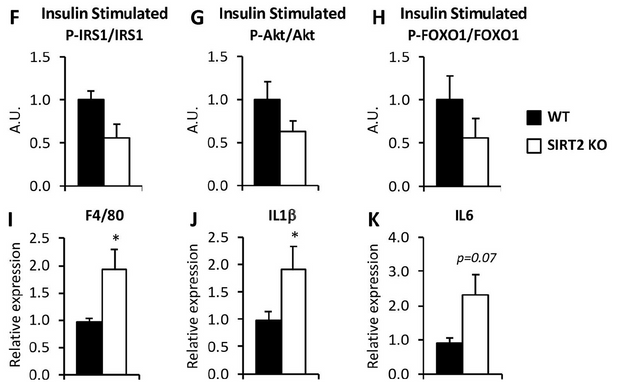
Reproduced from [1] Figure 6
Here we are looking at the phosphorylation levels of a few proteins IRS1, Akt (mentioned above) and FOXO1 (the functions of each aren't necessarily important for you to think about), the phosphorylation states of which are stimulated by insulin. We can see with the above data F-H that the SIRT2 knock out mice result in decreased phosphorylation of these proteins in the liver relative to the wild type mice. This indicates that the SIRT2 knock out mice have a reduced capacity to respond to insulin.
Additionally below this we are looking at m-RNA levels for three proteins which are involved in the inflammatory response and are considered to be 'pro inflammatory'. This inflammation is reported by the authors to be a contributing factor to the development of insulin resistance [7]. All three of these proteins are up-regulated in the livers of the SIRT2 mice. So it would seem that the SIRT2 knockout does result in a metabolic change, and also an inflammation response change.
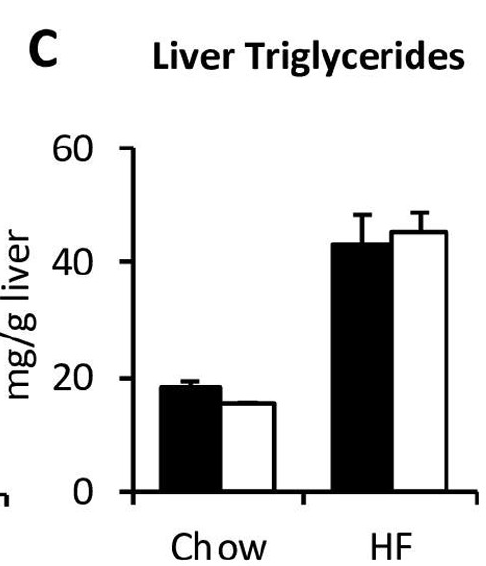 Reproduced from [1] Figure 6
Reproduced from [1] Figure 6One thing it didn't do, was result in higher liver triglyceride levels, which is associated with decreased insulin sensitivity (as seen in the figure to the right). One thing they did find was drastically increased levels of liver protein acetylation! (data not shown) This increase in acetylation was not dependent on whether the mice ate the normal or high fat diets, it was just a response to the knock out of SIRT2. The authors report that the acetylation increase was found in both the cytosol and mitochondria of the hepatocytes (AKA liver cell).
Conclusions
The authors showed that knock down of SIRT2 results in metabolic changes and increased insulin sensitivity in mice. Confirming their hypothesis. The data also indicates that SIRT2 may be involved in protecting against the development of insulin resistance when eating a high fat diet.
Citations
- https://journals.plos.org/plosone/article?id=10.1371/journal.pone.0208634
- https://www.ncbi.nlm.nih.gov/pubmed/27460777
- https://www.ncbi.nlm.nih.gov/pubmed/23864654
- https://www.ncbi.nlm.nih.gov/pubmed/24516071
- https://www.ncbi.nlm.nih.gov/pubmed/23864654
- https://www.ncbi.nlm.nih.gov/pubmed/22014574
- https://www.ncbi.nlm.nih.gov/pubmed/26154055
Simple studies like this can be easy to dismiss. They just compared a SIRT2 knockout to a WT strain for several months under different feeding conditions. However, it's impressive how many different measurements, from anatomical to biochemical to behavioral, that they did. And all that work only nets them a PLOS One paper....
Indeed, all that and only PLoS one. A situation that both you and I are familiar with eh?
Indeed. At least it's better than the work going unpublished :P
Hi @justtryme90!
Your post was upvoted by Utopian.io in cooperation with @steemstem - supporting knowledge, innovation and technological advancement on the Steem Blockchain.
Contribute to Open Source with utopian.io
Learn how to contribute on our website and join the new open source economy.
Want to chat? Join the Utopian Community on Discord https://discord.gg/h52nFrV
Hi @justtryme90!
Your post was upvoted by @steem-ua, new Steem dApp, using UserAuthority for algorithmic post curation!
Your UA account score is currently 6.356 which ranks you at #191 across all Steem accounts.
Your rank has not changed in the last three days.
In our last Algorithmic Curation Round, consisting of 215 contributions, your post is ranked at #149.
Evaluation of your UA score:
Feel free to join our @steem-ua Discord server
Congratulations @justtryme90! You have completed the following achievement on the Steem blockchain and have been rewarded with new badge(s) :
Click here to view your Board
If you no longer want to receive notifications, reply to this comment with the word
STOPDo not miss the last post from @steemitboard: